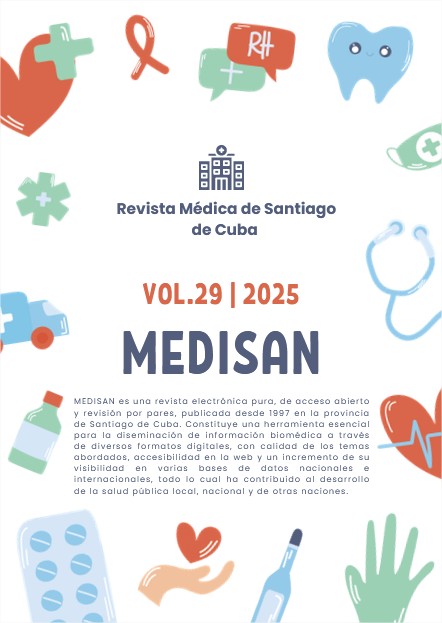Técnica de micronúcleos como medidora de salud ocupacional
Resumen
Introducción: La salud ocupacional tiene como principal objetivo disminuir los riesgos laborales y promueve la prevención de accidentes en el trabajo que se define como Medicina Ocupacional. Los micronúcleos actualmente son utilizados como biomarcadores para la detección de riesgo de la medicina del trabajo basado en la exposición a contaminantes ambientales y agentes químicos.
Objetivo: Describir las características epidemiológicas y la respuesta citogenética de trabajadores expuestos a través de la técnica de micronúcleos.
Métodos: Se registraron parámetros como la edad, el género, ocupación, variables hematológicas y técnica de micronúcleos.
Resultados: Predominó el género femenino, el grupo de edad de 40-49 años, no existió semejanza estadística ni clínica entre los implicados en el estudio y la técnica de micronúcleos fue negativa en todos los trabajadores expuestos.
Conclusiones: queda demostrada la sensibilidad de la técnica de micronúcleos como biomarcador para la detección del riesgo de enfermedad ocupacional.
Descargas
Citas
1. Marales K, Pacheco G, Viera P. Accidentabilidad laboral en el sector de la construcción: Ecuador, período 2016-2019. Revista Ingenio. 2021[citado 05/07/2024];4(2):37-47. Disponible en: https://revistadigital.uce.edu.ec/index.php/INGENIO/article/view/3206/4260
2. Gallegos M, Castillo, T. Eficiencia, carga de trabajo, salud y seguridad ocupacional en la industria de la construcción en las principales ciudades del Ecuador. Revista Novasinergia. 2022[citado 20/02/2025];5(1):150-62. Disponible en: http://scielo.senescyt.gob.ec/scielo.php?script=sci_arttext&pid=S2631-26542022000100150
3. Arellano García ME, Torres Bugarín O, García García MR, García Flores D, Toledano Magaña Y, Sanabria Mora CS, et al. Genomic Instability and Cyto-Genotoxic Damage in Animal Species. In: Updates on Veterinary Anatomy and Physiology. Edited by Catrin Sian Rutland and Samir A.A. El-Gendy. Intech Open. 2021[citado 01/12/2024]:1-19. Disponible en: https://www.intechopen.com/chapters/78242
4. Carracedo RT, Caliri MN, Ferré DM, Gorla NBM, Pedrosa A. Ensayo de micronúcleos citoma bucal en caninos: descripción histológica y citológica del epitelio: Buccal micronucleus cytome assay in canines: histological and cytolo-gical epithelial description. CU. Investigación, ciencia universidad. 2024[citado 06/01/2025];7(8):17. Disponible en: http://umaza.dspace.theke.io/handle/00261/3316
5. Williams RJ. The Declaration of Helsinki and public health. Bulletin of the World Health Organization. 2008[citado 25/07/2025];86:6502. Disponible en: https://www.scielosp.org/article/bwho/2008.v86n8/650652
6. Penchaszadeh VB. Ética de las investigaciones biomédicas en poblaciones humanas. Rev Cubana Salud Pública. 2002[citado06/01/2025];28(2):149-56. Disponible en: http://scielo.sld.cu/scielo.php?script=sci_arttext&pid=S0864-34662002000200005&lng=es.
7. Sanchez González, Rodríguez Rodríguez J, Galardi Martínez K, Matech Hernández L. Estándares reguladores de avanzada para medicamentos y productos biotecnológicos en Cuba. Revista Cubana de Farmacia. 2020[citado 06/01/2025];53(2):e423. Disponible en: https://www.medigraphic.com/pdfs/revcubfar/rcf-2020/rcf202h.pdf
8. Arnold Y. Bioseguridad y salud ocupacional en laboratorios biomédicos. Rev Cub Salud Trabajo. 2024[citado 06/01/2025];13(3):53-8. Disponible en: https://revsaludtrabajo.sld.cu/index.php/revsyt/article/view/601
9. Calixto Ramírez CA. Implementación de Plan de seguridad y salud ocupacional y la reducción de riesgos laborales en el Consorcio Vial Chimbote, 2022 [Tesis]. Universidad Nacional del Centro del Perú. Escuela de Posgrado. 2022[citado 06/08/2025]. Disponible en: http://scielo.sld.cu/scielo.php?script=sci_arttext&pid=S0034-75232024000100013&lng=es
10. Buzaglo GBB, Telles GD, Araújo RB, Junior GDS, Ruberti OM, Ferreira MLV.et al. The Therapeutic Potential of Physical Exercise in Cancer: The Role of Chemokines. International journal of molecular sciences. 2024[citado 06/07/2024];25(24):13740. Disponible en: https://pmc.ncbi.nlm.nih.gov/articles/PMC11678861/
11. Torres-Bugarín O, Martínez RS, Barajas AJG, Ríos-Esquivel PE, Ibarra MLR, García EA. Micronúcleos y anormalidades nucleares en células epiteliales orales: Herramienta eficaz y sencilla en la detección temprana de individuos altamente susceptibles a la inestabilidad genómica. Detección de individuos susceptibles a la inestabilidad genómica. Revista Bio Ciencias. 2024[citado 06/01/2025];11(e1650):1-24. Disponible en: https://revistabiociencias.uan.edu.mx/index.php/BIOCIENCIAS/article/view/1650
12. Chinemerem Nwobodo D, Ugwu MC, Oliseloke Anie C, Al-Ouqaili MT S, Chinedu Ikem J, Victor Chigozie U. et al. Antibiotic resistance: The challenges and some emerging strategies for tackling a global menace. Journal of clinical laboratory analysis. 2022[citado10/01/2025];36(9):e24655. https://doi.org/10.1002/jcla.24655
13. Sánchez Zepeda MY, López Herrera M, Gordillo Martínez AJ. Micronúcleos, índice mitótico y aberraciones cromosómicas como biomarcadores de genotoxicidad en Vicia faba por efecto de cadmio. ACI. 2019[citado 01/12/2024]; 10(1):1324-35. Disponible en: https://www.executivebs.org/publishing.cl/aci/2019/Vol10/Nro1/3-ACI1324-18-full.pdf
14. Ceballos DM, Fellows KM, Evans AE, Janulewicz PA, Lee EG, Whittaker SG. Perchloroethylene and Dry Cleaning: It’s Time to Move the Industry to Safer Alternatives. Frontiers in Public Health. 2021[citado: 1/12/2024];9(1-12). Disponible en: https://doi.org/10.3389/fpubh.2021.638082
15. Murcia JE, Martinez S, Martins V, Herrera D, Buitrago C, Velasquez A et al. Risk assessment and green chemistry applied to waste generated in university laboratories. Heliyon. 2023[citado 06/01/2025]; 9(5). Disponible en: https://doi.org/10.1016/j.heliyon.2023.e15900
Publicado
Cómo citar
Número
Sección
Licencia
Derechos de autor 2025 MEDISAN

Esta obra está bajo una licencia internacional Creative Commons Atribución 4.0.
Esta revista provee acceso libre e inmediato a su contenido bajo el principio de que hacer disponible gratuitamente investigación al público, apoya aún más el intercambio de conocimiento global. Esto significa que los autores/as conservarán sus derechos de autor y garantizarán a la revista el derecho de primera publicación de su obra, el cuál estará simultáneamente sujeto a la licencia internacional Creative Commons Atribución 4.0 que permite copiar y redistribuir el material en cualquier medio o formato para cualquier propósito, incluso comercialmente, además de remezclar, transformar y construir a partir del material para cualquier propósito.





